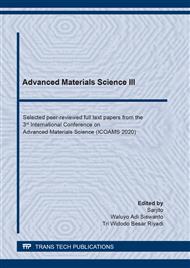[1]
E. Abbasi, Q. Luo, and D. Owens, A Comparison of Microstructure and Mechanical Properties of Low Alloy Medium Carbon Steels after Quench-Hardening,, Mater. Sci. Eng. A, (2018).
DOI: 10.1016/j.msea.2018.04.012
Google Scholar
[2]
H. Hariningsih, S. Sumpena, and H. Sukarja, The effectivity of used-oil as quenching medium of 42-CrMo4 steel for automotive materials,, Appl. Res. Smart Technol., vol. 1, p.28–34, (2020).
DOI: 10.23917/arstech.v1i1.11
Google Scholar
[3]
G.E. Totten, Steel Heat Treatment, Second. Oregon: CRC Press Taylor & Francis Group, (2006).
Google Scholar
[4]
J. Sun, H. Yu, S. Wang, and Y. Fan, Study of microstructural evolution, microstructure-mechanical properties correlation and collaborative deformation-transformation behavior of quenching and partitioning ( Q & P ) steel,, Mater. Sci. Eng. A, vol. 596, p.89–97, (2014).
DOI: 10.1016/j.msea.2013.12.054
Google Scholar
[5]
X. Han, G. Barber, Z. Zhang, and B. Wang, Austenite-Bainite Transformation Kinetics in Austempered AISI 5160 Steel,, no. April, (2018).
DOI: 10.19044/esj.2018.v14n12p1
Google Scholar
[6]
Balkhaya, M.P. Anhar, Suwarno, and M.S.M. Sani, Investigation of knife quality by using forging and flame hardening methods,, in IOP Conference Series: Materials Science and Engineering, 2019, p.1–5.
DOI: 10.1088/1757-899x/506/1/012004
Google Scholar
[7]
J. Zhao, Z. Jiang, and C.S. Lee, Enhancing impact fracture toughness and tensile properties of a microalloyed cast steel by hot forging and post-forging heat treatment processes,, Mater. Des., vol. 47, p.227–233, (2012).
DOI: 10.1016/j.matdes.2012.11.051
Google Scholar
[8]
D. V Edmonds, K. He, F.C. Rizzo, B.C. De Cooman, D.K. Matlock, and J.G. Speer, Quenching and Partitioning Martensite — A Novel Steel Heat Treatment,, Mater. Sci. Eng. A, vol. 440, p.25–34, (2006).
DOI: 10.1016/j.msea.2006.02.133
Google Scholar
[9]
S. Ying and H. Dong, The Third Generation Auto Sheet Steel: Theory and Practice,, in Proceedings of the FISITA 2012 World Automotive Congress, 2013, p.933–947.
DOI: 10.1007/978-3-642-33835-9_86
Google Scholar
[10]
H.L. Yi, S. Ghosh, and H.K.D.H. Bhadeshia, Dual-phase hot-press forming alloy,, Mater. Sci. Eng. A, vol. 527, no. 18–19, p.4870–4874, (2010).
DOI: 10.1016/j.msea.2010.04.022
Google Scholar
[11]
M. Naderi, M. Ketabchi, M. Abbasi, and W. Bleck, Semi-hot Stamping as an Improved Process of Hot Stamping,, vol. 27, no. 4, p.369–376, (2011).
DOI: 10.1016/s1005-0302(11)60076-5
Google Scholar
[12]
S. Allain et al., Toward a new interpretation of the mechanical behaviour of as-quenched low alloyed martensitic steels,, ISIJ Int., vol. 52, p.717–722, (2012).
DOI: 10.2355/isijinternational.52.717
Google Scholar
[13]
Y. Wang et al., Super strength of 65Mn spring steel obtained by appropriate quenching and tempering in an ultra fi ne grain condition,, Mater. Sci. Eng. A, vol. 754, no. January, p.1–8, (2019).
DOI: 10.1016/j.msea.2019.03.059
Google Scholar
[14]
L. Xu, L. Chen, and W. Sun, Effects of soaking and tempering temperature on microstructure and mechanical properties of 65Si2MnWE spring steel,, vol. 154, no. April, p.322–332, (2018).
DOI: 10.1016/j.vacuum.2018.05.029
Google Scholar
[15]
T.S. Wang, J. Yang, C.J. Shang, X.Y. Li, B. Zhang, and F.C. Zhang, Microstructures and impact toughness of low-alloy high-carbon steel austempered at low temperature,, Scr. Mater., vol. 61, no. 4, p.434–437, (2009).
DOI: 10.1016/j.scriptamat.2009.04.038
Google Scholar
[16]
K. Chen et al., Effect of quenching and tempering temperature on microstructure and tensile properties of microalloyed ultra-high strength suspension spring steel,, Mater. Sci. Eng. A, vol. 766, no. June, p.138272, (2019).
DOI: 10.1016/j.msea.2019.138272
Google Scholar
[17]
ASTM Standard E407-99, Standard Practice for Microetching Metals and Alloys. West Conshohecken: ASTM International, (1999).
Google Scholar
[18]
ASTM Standard, ASTM E92-17 Standard Test Methods for Vickers Hardness and Knoop Hardness of Metallic. West Conshohecken: ASTM International, (2017).
Google Scholar
[19]
W.D. Callister, Materials Science and Engineering, 7th ed. USA: John Willey & Son INC, (2007).
Google Scholar
[20]
J. Zhang, H. Di, Y. Deng, and R.D.K. Misra, Effect of martensite morphology and volume fraction on strain hardening and fracture behavior of martensite – ferrite dual phase steel,, Mater. Sci. Eng. A, vol. 627, p.230–240, (2015).
DOI: 10.1016/j.msea.2015.01.006
Google Scholar
[21]
P. Jimbert, M. Iturrondobeita, J. Ibarretxe, and R.F. Martinez, Influence of Cryogenic Treatment on Wear Resistance and Microstructure of AISI A8 Tool Steel,, Metals (Basel)., vol. 8, p.1–11, (2018).
DOI: 10.3390/met8121038
Google Scholar
[22]
T. Nishibata and N. Kojima, Effect of quenching rate on hardness and microstructure of hot-stamped steel,, J. Alloys Compd., p.1–6, (2012).
DOI: 10.1016/j.jallcom.2011.12.154
Google Scholar


